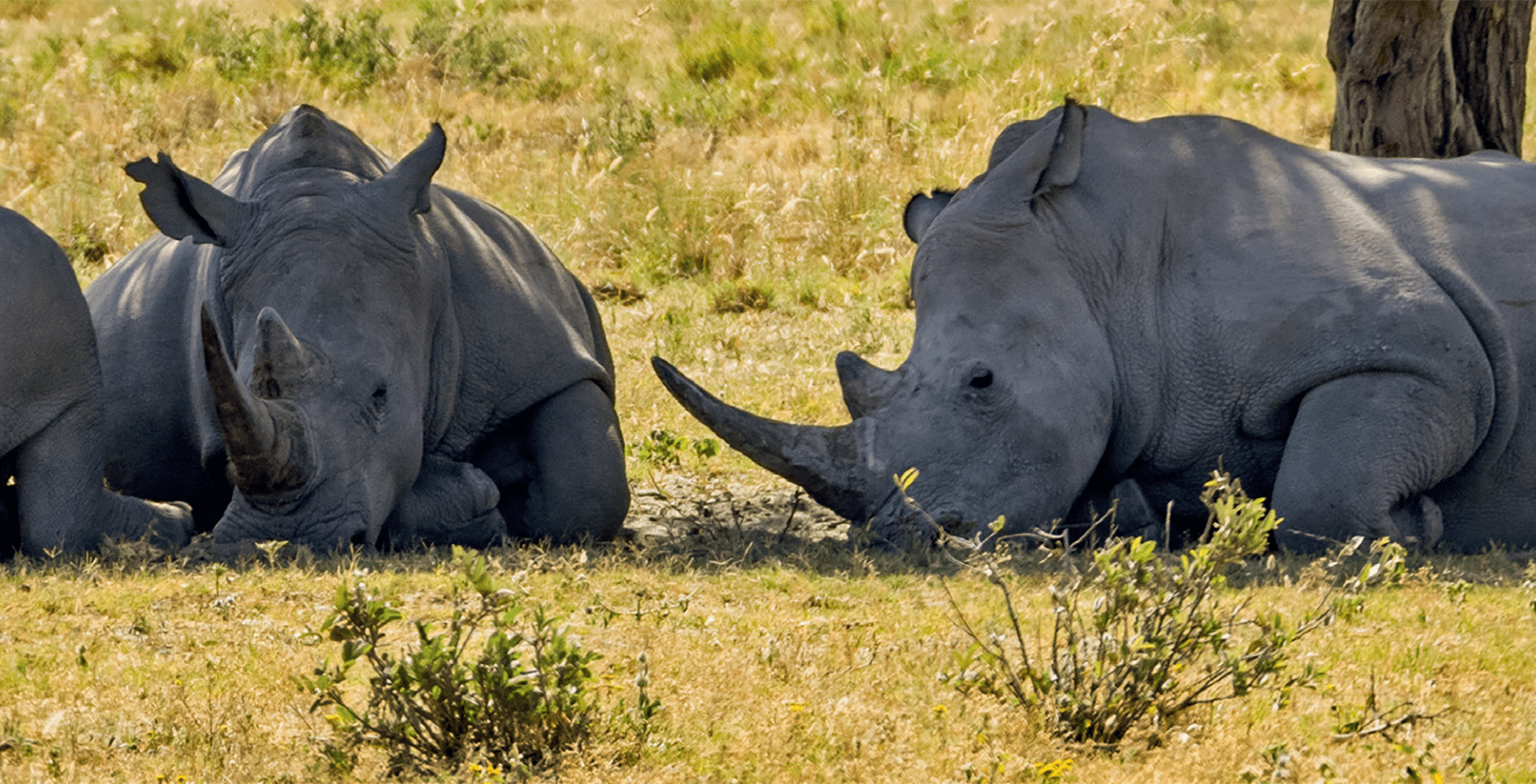The threat of extinction and how Artificial Intelligence could save the day

Summary
WALL-E is the last robot left on Earth. He spends his days tidying up the deserted, uninhabitable planet, when he falls in love with EVE – a sleek looking robot sent to analyse Earth for life. Although this is a fictional story created by Disney Pixar*¹, the storyline is profound – WALL-E finds the last plant in the world and lovingly takes care of it, sending a powerful and symbolic message about biodiversity and its importance for human survival.
|
|
Download the article here |

Families, communities and entire nations rely on biodiversity. It is what supports the web of life that protects our crops, the animals we rear and the water we drink. According to Taskforce on Nature-related Financial Disclosures "More than half of the world’s economic output – USD 44 trillion of economic value generation – is moderately or highly dependent on nature. The recorded extinction of 83% of wild mammals and 50% of plants therefore represents significant risk to corporate and financial stability.”2
Moreover, its loss could lead to an increase in the rate of disease transmission – a pertinent point during these pandemic times. This is because greater biodiversity creates a natural defence against infectious diseases spreading.3
According to the UN, nature is declining globally at an unprecedented rate in human history. Huge transformative changes will be needed to both restore and protect nature from this destruction4, and to close the immense USD 4.1 trillion private sector financing gap in nature by 2050, required to preserve biodiversity and restore forests.5 In the digital age that we are now entering, artificial intelligence (AI) could offer the human race the chance to meet these challenging goals and, in turn, allow us to survive and thrive.
How AI could make a real difference
These are the solutions that AI provides that are so valuable
It’s not just its mastery of the complex and fast datasets that make it valuable. It’s also the speed at which AI can detect, understand and provide solutions. At this moment in time speed is of the essence. Consequently, AI could be our great ally in preventing the loss of biodiversity.
Allianz Global Artificial Intelligence
Artificial intelligence has been transforming our lives and disrupting industries for years and yet we are only at the beginning of this vast structural trend. Our Allianz Global Artificial Intelligence fund offers investors global and diversified exposure to the Artificial Intelligence theme. It is not built to be a technology fund.
The fund invests across the full market capitalisation. However, our focus is on mid-cap and large-cap instead of primarily on mega-cap companies. Most importantly, we are investing along the full value chain from technology companies that develop infrastructure and enable the application of AI, to the companies across many sectors and industries adopting AI in their products, solutions and business processes. Artificial Intelligence will disrupt every industry in the future and so offers plenty of diverse investment opportunities for those with the right knowledge and expertise.
Our portfolio management team is based in San Francisco, providing them unique access to many of the key players in this space. This results in a continuous dialogue with both established players and start-ups, plus a better understanding of how AI is developing and proliferating. In addition, the Allianz Global Investors Global Research platform provides a global, cross-sector perspective. With a comprehensive understanding of the underlying technology and businesses, our team is best placed to understand the opportunities that Artificial Intelligence presents for all areas of the global economy.
1 Wikipedia contributors. (2021, June 14). WALL-E. Wikipedia. https://en.wikipedia.org/wiki/WALL-E
2 TNFD, 4 June 2021 https://tnfd.info/news/the-taskforce-on-nature-related-financial-disclosures-tnfd-officially-launches/
3 Keesing, F., & Ostfeld, R. S. (2021). Impacts of biodiversity and biodiversity loss on zoonotic diseases. Proceedings of the National Academy of Sciences, 118(17), e2023540118. https://doi.org/10.1073/pnas.2023540118
4 United Nations. (2019). UN Report: Nature’s Dangerous Decline “Unprecedented”; Species Extinction Rates “Accelerating.” United Nations Sustainable Development. https://www.un.org/sustainabledevelopment/blog/2019/05/nature-decline-unprecedented-report/
5 UNEP report 5 May 2021: https://www.unep.org/resources/state-finance-nature
6 NatureServe Habitat Models for Imperiled Species | NatureServe.org 2021 https://habitatsuitabilitymodeling-natureserve.hub.arcgis.com/pages/the-map-of-biodiversity-importance
7 Abdenur, A. E., & →. (2020, November 24). How Can Artificial Intelligence Help Curb Deforestation in the Amazon? IPI Global Observatory. https://theglobalobservatory.org/2020/11/how-can-artificial-intelligence-help-curb-deforestation-amazon/
8 Rainforest Connection 2021 | rfcx.org
9 Snow, J. (2021, May 4). Rangers Use Artificial Intelligence to Fight Poachers. Animals. https://www.nationalgeographic.com/animals/article/paws-artificial-intelligence-fights-poaching-ranger-patrols-wildlife-conservation
10 ZSL Publications 2020 | https://zslpublications.onlinelibrary.wiley.com/doi/10.1002/rse2.195
11 3BL CSR Wire 2020 | https://www.csrwire.com/press_releases/45814-wildeyes-ai-helping-to-protect-wild-rhinos-from-poachers-and-track-species-recovery
12 Interview: How Can We Make AI More Environmentally Friendly? | Climate Protection. (2020, April 2). RESET.To. https://en.reset.org/blog/interview-how-can-we-make-ai-more-environmentally-friendly-04022020
13 Source: The European Marine Energy Centre Ltd, 10 February 2021 http://www.emec.org.uk/press-release-emec-and-h2go-power-trial-ai-green-technology/
14 The latest weapons in the fight against ocean plastic? Drones and an algorithm. (2018, June 12). World Economic Forum. https://www.weforum.org/agenda/2018/06/this-ai-is-learning-to-recognize-ocean-plastic-using-drone-photos
15 “Cyber-Risk Oversight Handbook For Corporate Boards,” OAS.13 “Cyber-Risk Oversight Handbook For Corporate Boards,” OAS.
16 Chenxi Wang, “Corporate Boards Are Snatching Up Cybersecurity Talents,” Forbes, August 2019.Available: https://www.forbes.com/sites/chenxiwang/2019/08/30/corporateboards-are-snatching-up-cybersecurity-talents/#615246a479f5
Investing involves risk. The value of an investment and the income from it may fall as well as rise and investors might not get back the full amount invested. The views and opinions expressed herein, which are subject to change without notice, are those of the issuer companies at the time of publication. The data used is derived from various sources, and assumed to be correct and reliable at the time of publication. The conditions of any underlying offer or contract that may have been, or will be, made or concluded, shall prevail. The Management Company may decide to terminate the arrangements made for the marketing of its collective investment undertakings in accordance with applicable de-notification regulation. The duplication, publication, or transmission of the contents, irrespective of the form, is not permitted; except for the case of explicit permission by Allianz Global Investors GmbH.
For investors in Europe (excluding Switzerland)
This is a marketing communication issued by Allianz Global Investors GmbH, www.allianzgi.com, an investment company with limited liability, incorporated in Germany, with its registered office at Bockenheimer Landstrasse 42-44, 60323 Frankfurt/M, registered with the local court Frankfurt/M under HRB 9340, authorised by Bundesanstalt für Finanzdienstleistungsaufsicht (www.bafin.de).
The Summary of Investor Rights is available in English, French, German, Italian and Spanish at https://regulatory.allianzgi.com/en/investors-rights
Allianz Global Investors GmbH has established branches in the United Kingdom, France, Italy, Spain, Luxembourg, Sweden, Belgium and the Netherlands. Contact details and information on the local regulation are available here (www.allianzgi.com/Info).
For investors in Switzerland
This is a marketing communication issued by Allianz Global Investors (Schweiz) AG, a 100% subsidiary of Allianz Global Investors GmbH.
AdMaster: 1701538
Cybercrime: being bad is big business

Summary
As hackers continue to grow in ambition and sophistication, the risks and costs of cybercrime are rising. Indiscriminately, governments, powerful institutions, big business and individuals have all proved vulnerable. Cybersecurity is multi-layered and multi-faceted but companies that provide solutions to tackle the ever evolving threats are in a position to provide a long-term growth opportunity for investors.










CONSERVATION
AI could be very valuable if introduced to conservation efforts. Advanced satellite and drone technology used for detailed surveillance of species generates vast amounts of valuable data. However, it would be of little use without AI and its ability to process information very quickly, enabling faster than humanly possible intelligence gathering. This in turn will help us build up our knowledge on why biodiversity is being lost and come up with solutions to stop it.
We are already starting to see AI being used for this purpose and with success.
Image source: NatureServe 2021.
Protecting species “Map of biodiversity importance” by NatureServe*
A project called the "Map of Biodiversity Importance” created by NatureServe supported by Esri*, The Nature Conservancy* and Microsoft's* AI for Earth programme monitors the level of biodiversity that is at risk in the United States. Using “machine learning and environmental predictor variables, it is able to model habitats for 2,216 species” and visualise big data in the form of maps, helping the process of rebuilding biodiversity across regions.6
Preventing deforestation – maintaining forests' optimal conditions by Gramemer*
Forests cover 31% of the planet and are home to 80% of the world's terrestrial species of animals and plants. Deforestation is destroying the rich biodiversity that forests hold in several parts of the world. The problem is particularly acute in the Amazon basin, where the destruction of forests is largely driven by illegal activities such as land invasions, induced forest fires and illegal mining and logging activities.
Whilst advanced surveillance of forest canopies is already in place, it is the filtering of the large amounts of data collected that is the problem, which is prohibitively expensive for humans to do it themselves. This is where AI could make a difference.
AI can identify plant and tree species with 85% accuracy at a comparable level to a human.
Some of the most promising innovations in the prevention of deforestation have come from AI. For instance, data science company Gramemer uses neural networks to identify different plant and tree species with 85% accuracy, which is a level comparable to what humans can achieve but at much greater speed. Companies like IBM* are using sensors to monitor rainforests and combining this with analytics-driven software that can process up to 10,000 data points per second. The types of information they collect include carbon levels, soil moisture, relative humidity and atmospheric pressure among other things. This can be used to predict droughts and possible forest fires. It can also show how rainforests respond to deforestation and climate change.7
There are even more innovative techniques being used. Non-profit organisation, Rainforest Connection*, is using recycled cell phones in rainforests to send instant notifications when the sound of a chainsaw or something associated with illegal deforestation is detected.8
Tackling poaching and tracking endangered species - WildEyes ™ AI camera-based alert systems by RESOLVE* and CVEDIA*
On average about 96 African elephants are killed every day by poachers. There is a risk that African elephants could disappear completely within our own lifetimes if something is not done about it.
Image source: resolve.ngo 2021.
AI can be used to analyse data related to poaching collected by wildlife authorities over many years, including animal sightings, snares, animal remains and more. AI algorithms could then be used to understand the behaviour of poachers. They could also be used to help enhance wildlife patrols by making them more effective.9
Dr Olga Isupova, a computer scientist at the University of Bath, came up with an algorithm, using drones, low-flying aircraft and AI technology called convolutional neural networks (CNN) used to analyse visual imagery, that reveals the location of animals across very broad areas of land and helps to track, count and protect them.10
WildEyes ™ AI camera-based alert systems developed by RESOLVE and CVEDIA are tiny devices, hidden away from poachers, that capture rhinos (whose survival have been particularly at risk) in their natural habitat. When the camera's motion sensors are triggered, the computer algorithm detects whether rhinos or humans are in the shot of the camera. Images are then transmitted in near real-time to smartphones carried by the rangers. These cameras can be very powerful in the fight against poaching and can be placed strategically along suspected poacher trails.11
POSITIVE IMPACT ON THE ENVIRONMENT
Green energy generation
Despite the potential AI has to protect the environment and tackle climate change, there are issues. For instance, the computing power that AI requires can be significant, resulting in large amounts of electricity being consumed. However, according to Stephan Richter "AI is a tool, not a solution". 12
Every technology has negative externalities, but it is how you use technology that can make a difference. For instance, if you can use AI to reduce carbon emissions and increase the use of renewable energy, then you also reduce the negative environmental impact of AI. The energy sector could, therefore, significantly benefit from the use of AI. This sector naturally releases huge amounts of greenhouse gases and AI could have a positive impact by helping reduce emissions.
HyAI (AI-controlled hydrogen storage technology) could significantly optimise green energy generation and integration into the grid.13
Eradicating plastic
In certain parts of the Pacific Ocean, there are armies of drones measuring the amount of plastic waste in our oceans. They use mounted cameras that take thousands of aerial photos on each trip. These photos are then sent to an AI algorithm that is designed to recognise plastic and distinguish it from other objects such as seashells and jellyfish. This is then used to create an open source map that can be used to focus on those areas of the ocean where the most attention is needed.14
This innovative technology can be used to track and trace plastic waste so that a solution can be found at the source of the problem. AI can also be used to create data simulations and models that can predict where ocean plastic might build up. Through this process, AI may discover patterns or observations that might have been previously unnoticed.